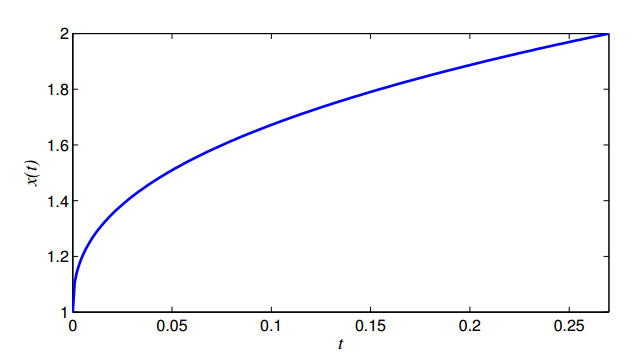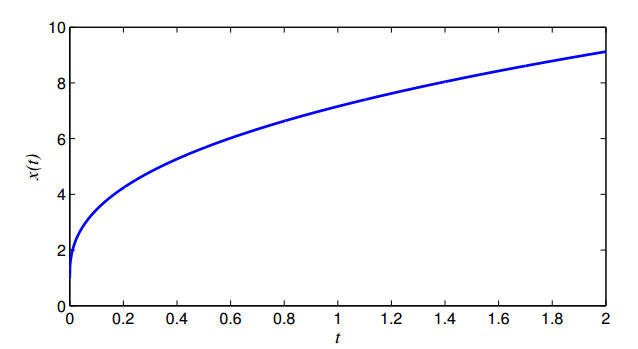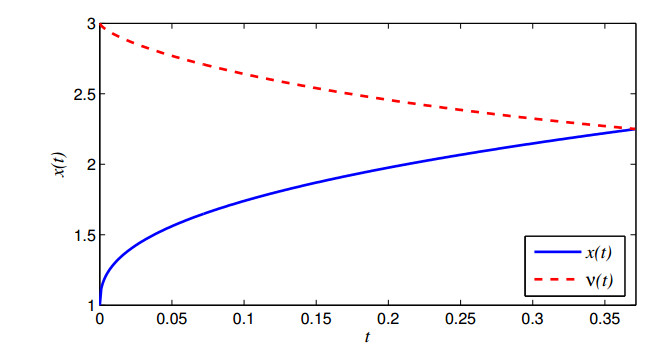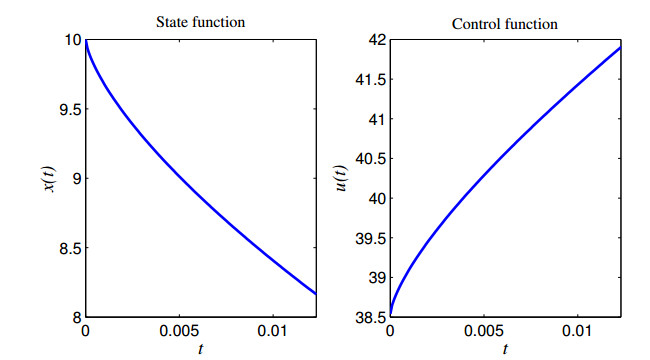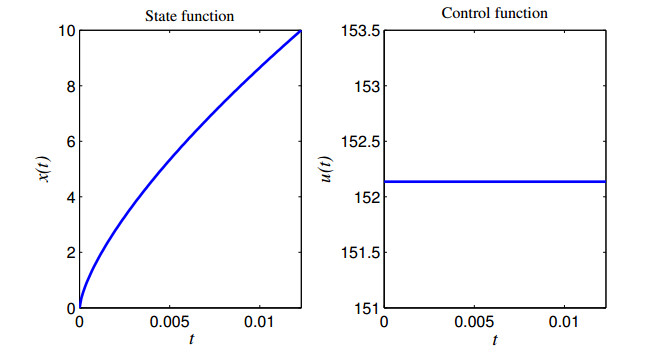This paper provides generalized transversality conditions for the problems of variational calculus and optimal control, constructed by the conformable derivative. The generalized term is used to emphasize the problems with performance indexes containing the conformable derivative and defined by the classical integral and to distinguish them from the problems with performance indexes defined by the conformable integral. Special cases of the generalized transversality conditions both for variational calculus and optimal control are exhibited and supported by illustrative examples.
1.
Introduction
The theory of fractional calculus has played an important role in engineering and natural sciences. Currently, the concept of fractional calculus has been effectively used in many social, physical, signal, image processing, biological and engineering problems. Further, it has been realized that a fractional system provides a more accurate interpretation than the integer-order system in many real modeling problems. For more details, one can refer to [1,2,3,4,5,6,7,8,9,10].
Oscillation phenomena take part in different models of real world applications; see for instance the papers [11,12,13,14,15,16,17] and the papers cited therein. More precisely, we refer the reader to the papers [18,19] on bio-mathematical models where oscillation and/or delay actions may be formulated by means of cross-diffusion terms. Recently and although it is rare, the study on the oscillation of fractional partial differential equations has attracted many researchers. In [20,21,22,23], the researchers have established the requirements of the oscillation for certain kinds of fractional partial differential equations.
In [24], Luo et al. studied the oscillatory behavior of the fractional partial differential equation of the form
subject to either of the following boundary conditions
They have obtained some sufficient conditions for the oscillation of all solutions of this kind of fractional partial differential equations by using the integral averaging technique and Riccati transformations.
On other hand in [25], Xu and Meng considered a fractional partial differential equation of the form
with the Robin boundary condition
they obtained some oscillation criteria using the integral averaging technique and Riccati transformations.
Prakash et al. [26] considered the oscillation of the fractional differential equation
with the Neumann boundary condition
they obtained some oscillation criteria by using the integral averaging technique and Riccati transformations.
Furthermore in [27], Ma et al. considered the forced oscillation of the fractional partial differential equation with damping term of the form
with the boundary condition
they obtained some oscillation criteria by using the integral averaging technique.
From the above mentioned literature, one can notice that the Riccati transformation method has been incorporated into the proof of the oscillation results. Unlike previous results, however, we study in this paper the forced oscillation of the fractional partial differential equation with the damping term of the form
via the application of the integral averaging technique only. Equation (1.1) is presented under a high degree of generality providing a general platform for many particular cases. Here, Dα+,tu(y,t) is the Riemann-Liouville fractional partial derivative of order α of u,α∈(0,1), Δ is the Laplacian in Rn, i.e.,
Q is a bounded domain of Rn with the piecewise smooth boundary ∂Q and R+:=(0,∞).
Further, we assume the Robin and Dirichlet boundary conditions
and
where N is the unit outward normal to ∂Q and γ(y,t)>0 is a continuous function on ∂Q×R+. The following conditions are assumed throughout:
(H1) a(t)∈C1([t0,∞);R+) and r(t)∈C2([t0,∞);R+);
(H2) g(t)∈C2(R;R) is an increasing function and there exists a positive constant k such that yg(y)=k>0, yg(y)≠0 for y≠0;
(H3) p(t)∈C([t0,∞);R) and A(t)=∫tt0p(ζ)a(ζ)dζ;
(H4) b(t),ai(t)∈C(R+;R+) and τi are non-negative constants, i∈Im={1,2,…,m};
(H5) q(y,t)∈C(H;R+) and q(t)=miny∈Qq(y,t);
(H6) f(y,t)∈C(ˉH;R).
By a solution of the problems (1.1) and (1.2) (or (1.1)–(1.3)), we mean a function u(y,t)∈C2+α(ˉQ×[0,∞)), which satisfies (1.1) on H and the boundary condition (1.2) (or (1.3)).
A solution u(y,t) of (1.1) is said to be oscillatory if it is neither eventually positive nor eventually negative. Otherwise, it is non-oscillatory.
The rest of the paper is organized as follows. Some basic definitions and known lemmas are included in Section 2. In Sections 3 and 4, we study the oscillations of (1.1) and (1.2), and (1.1) and (1.3), respectively. Section 5 deals with some applications for the sake of showing the feasibility and effectiveness of our results. Lastly, we add a conclusion in Section 6.
2.
Preliminaries
Before we start the main work, we present some basic lemmas and definitions which are applied in what follows.
Definition 1. [4] The Riemann-Liouville fractional integral of order α>0 of a function y:R+→R on the half-axis R+ is defined by
provided the right-hand side is pointwise defined on R+, where Γ is the gamma function.
Definition 2. [4] The Riemann-Liouville fractional derivative of order α>0 of a function y:R+→R on the half-axis R+ is defined by
provided the right-hand side is pointwise defined on R+, where ⌈α⌉ is the ceiling function of α.
Definition 3. [4] The Riemann-Liouville fractional partial derivative of order 0<α<1 with respect to t of a function u(y,t) is defined by
provided the right-hand side is pointwise defined on R+.
Lemma 1. [4] Let y be a solution of (1.1) and
for α∈(0,1) and t>0. Then
Lemma 2. [4] Let α≥0,m∈N and D=ddt. If the fractional derivatives (Dαa+y)(t) and (Dα+ma+y)(t) exist, then
Lemma 3. [4] If α∈(0,1), then
where y1−α(t)=(I1−αa+y)(t).
Lemma 4. [5] The smallest eigenvalue β0 of the Dirichlet problem
is positive and the corresponding eigenfunction ϕ(y) is positive in Q.
3.
Oscillation of (1.1) and (1.2)
In this section, we establish the oscillation criteria for (1.1) and (1.2).
Theorem 1. If (H1)−(H6) are valid, limt→∞I1−α+U(0)=C0 and if
and
for some constants C0,C1 and C2 with F(t)=∫Qf(y,t)dy, then all solutions of (1.1) and (1.2) are oscillatory.
Proof. If u(y,t) is a non-oscillatory solution of (1.1) and (1.2) then there exists a t0≥0 such that u(y,t)>0 (or u(y,t)<0),t≥t0.
Case 1. Let u(y,t)>0 for t≥t0. Integrating (1.1) over Q, we get
where U(t)=∫Qu(y,t)dy with U(t)>0. By (1.2) and Green's formula, we have
and
Also, by (H5), one can get
where L(t)=∫t0(t−ℏ)−αU(ℏ)dℏ. Because of the inequalities (3.4)–(3.6), (3.3) becomes
Thus, we get
Integrating the above inequality over [t0,t], one can get
where
Again integrating the above inequality over [t0,t], we get
where C2=r(t0)g(Dα+U(t0)). Then using (H5), we obtain
Applying the Riemann-Liouville fractional integral operator of order α to the above inequality and using Lemma 3, we obtain
Then
Therefore, by our hypothesis, as given by (3.1), we get lim inft→∞U(t)≤0. This leads to a contradiction to U(t)>0.
Case 2. Let u(y,t)<0 for t≥t0. Just as in Case 1, we can obtain that (3.3) holds and U(t)<0. By (1.2) and Green's formula, we get
and
Also, by (H5), we have
Because of the inequalities (3.7)–(3.9), (3.3) becomes
that is,
Integrating the above inequality over [t0,t], we have
where
Again integrating the above inequality over [t0,t], we obtain
where C2=r(t0)g(Dα+U(t0)). Then using (H5), we obtain
Applying the Riemann-Liouville fractional integral operator of order α to the above inequality and using Lemma 3, we obtain
Then
Therefore, by our hypothesis given by (3.2), we get lim supt→∞U(t)≥0. This leads to a contradiction to U(t)<0.
4.
Oscillation of (1.1) and (1.3)
In this section, we establish the oscillation criteria for (1.1) and (1.3).
Theorem 2. If (H1)−(H5) are valid, limt→∞I1−α+U1(0)=A1 and if
and
for some constants A1,C1 and C2 with
then all solutions of (1.1) and (1.3) are oscillatory.
Proof. If u(y,t) is a non-oscillatory solution of (1.1) and (1.3) then there exists a t0≥0 such that u(y,t)>0 (or u(y,t)<0) for t≥t0.
Case 1. Let u(y,t)>0 for t≥t0. Multiplying (1.1) by ϕ(y) and then integrating over Q, we get
By Lemma 4 and Green's formula, we have
and
Also, by (H5), we get
where
Because of the inequalities (4.4)–(4.6), (4.3) becomes
that is,
Integrating the above inequality over [t0,t], we have
where
Again integrating the above inequality over [t0,t], we have
where C2=r(t0)g(Dα+U1(t0)). Then using (H5), we obtain
Applying the Riemann-Liouville fractional integral operator of order α to the above inequality and using Lemma 3, we obtain
Then
Therefore, by our hypothesis given by (4.1), we get lim inft→∞U1(t)≤0. This leads to a contradiction to U1(t)>0.
Case 2. Let u(y,t)<0 for t≥t0. Multiplying (1.1) by ϕ(y) and then integrating over Q, one can get (4.3). Using Green's formula, we have
and
Also, by (H5), we have
where
Because of the inequalities (4.7)–(4.9), (4.3) becomes
that is,
Integrating the above inequality over [t0,t], we get
where
Again integrating the above inequality over [t0,t], we get
where C2=r(t0)g(Dα+U1(t0)). Then using (H5), we obtain
Applying the Riemann-Liouville fractional integral operator of order α to the above inequality and using Lemma 3, we obtain
Then
Therefore, by our hypothesis given by (4.2), we get lim supt→∞U1(t)≥0. This leads to a contradiction to U1(t)<0.
5.
Applications
In this section, we give two examples to illustrate our main results.
Example 1. Let us consider the fractional partial differential system
with the condition
In the above, a(t)=1,r(t)=1,g(t)=t,α=1/2,p(t)=0,b(t)=1/π,m=1,a1(t)=2t,τ1=1, q(y,t)=(y2+1t2),f(y,t)=e2tcos(t)sin(y),Q=(0,π),q(t)=miny∈(0,π)q(y,t)=1/t2 and t0=0.
Since F(t)=∫π0e2tcos(t)sin(y)dy=2e2tcos(t) and A(t)=0, we have
Fixing y2=t−ℏ, then
Pointing out that
we can conclude that
are convergent. Thus, we have that
is convergent. Fixing
and considering the sequence
we get
Since limn→∞tn=∞, from (5.3), we have
Similarly, fixing
we get
Thus, from (5.3), we can get
Therefore, by referring to Theorem 1, the solutions of (5.1) and (5.2) are oscillatory.
Example 2. Let us consider the fractional partial differential system
with the condition
In the above, a(t) = 1 , r(t) = \frac{1}{1875\sqrt{\pi}} , g(t) = t , \alpha = 1/2 , p(t) = 0 , b(t) = \frac{1}{2\times 10^{5} t^{\frac{5}{2}}} , m = 1 , a_{1}(t) = \frac{1}{2\times 10^{5} t^{\frac{5}{2}}} , \tau_{1} = 0 , q(y, t) = \frac{-16}{75\times 10^{2}\pi t^{3}}+\frac{16e^{2 t}\cos (t)}{5\pi t^{3}}, f(y, t) = e^{2 t}\cos (t) \sin (y), Q = (0, \pi), q(t) = \min_{y\in(0, \pi)}q(y, t) = \frac{-16}{75\times 10^{2}\pi t^{3}}+\frac{16e^{2 t}\cos (t)}{5\pi t^{3}} and t_{0} = 0 . It is obvious that \beta_{0} = 1 and \phi(y) = \sin (y). Since F_{1}(t) = \int_{0}^{\pi}e^{2 t}\cos (t) \cos(10y) \sin (y) dy = \frac{-2}{99}e^{2 t}\cos (t) and A(t) = 0, we have
Fixing y^{2} = t-\hbar , then
Pointing out that
we can conclude that
are convergent. Thus, we have that
is convergent. Fixing
and considering the sequence
we get
Since \lim\limits_{n\to\infty} t_{n} = \infty , from (5.6), we have
Similarly, fixing
we get
Thus, from (5.6), we get
Therefore, by referring to Theorem 2, the solutions of (5.4) and (5.5) are oscillatory. In fact, u(y, t) = t^{5/2}\cos(10y) is a solution of (5.4) and (5.5) and its oscillatory behavior is demonstrated in Figure 1.
6.
Conclusions
In this paper, we have obtained some new oscillation results for the fractional partial differential equation with damping and forcing terms under Robin and Dirichlet boundary conditions. The main results are proved by using only the integral averaging technique and without implementing the Riccati approach. Further, the obtained results are justified by some examples which can not be commented upon by using the previous results. Our results have been obtained for the general equation which may cover other particular cases.
Acknowledgments
A. Palanisamy was supported by the University Grants Commission (UGC-Ref. No.: 958/(CSIR-UGC NET JUNE 2018)), New Delhi, India and the third author was partially supported by the DST-FIST Scheme (Grant No. SR/FST/MST-115/2016), New Delhi, India. J. Alzabut is thankful to Prince Sultan University and Ostim Technical University for their endless support. The authors are grateful to the reviewers for their precious help in improving this manuscript.
Conflict of interest
The authors declare that they have no conflicts of interest.










 DownLoad:
DownLoad:


